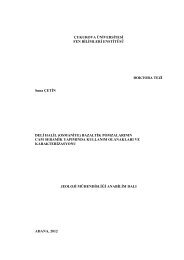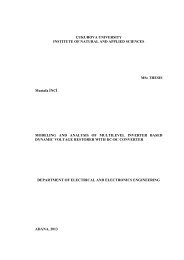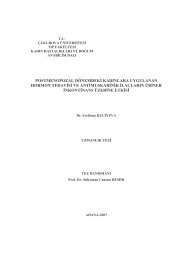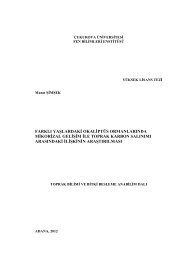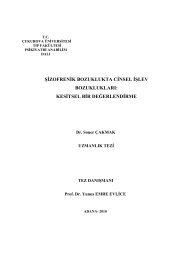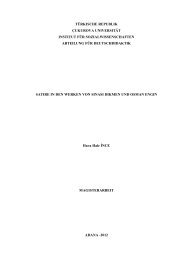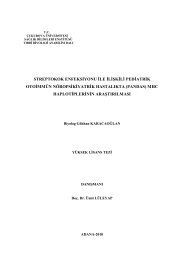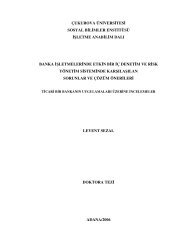Mentagrophytes - Çukurova Üniversitesi
Mentagrophytes - Çukurova Üniversitesi
Mentagrophytes - Çukurova Üniversitesi
Create successful ePaper yourself
Turn your PDF publications into a flip-book with our unique Google optimized e-Paper software.
54. Valdigem Gl, Pereira T, Macedo C, et al. A twenty-year survey of dermatophytoses in Braga,<br />
Portugal. Int J Dermatol, 2006; 45:822-827.<br />
55. Kane J, Fischer J. Occurrence of Trichophyton megninii in Ontario. Identification with a simple<br />
cultural procedure. J Clin Microbiol, 1975; 2:111-114.<br />
56. Sequeria H, Cabrita J, de Vroey C, Wuytack-Raes C. Contribution to our knowledge of<br />
Trichophyton megninii. J Med Vet Mycol, 1991; 29:417-418.<br />
57. Kane J, Salkin IF, Weitzman I, Smitka C. Trichophyton raubitschekii, sp. nov. Mycotaxon,<br />
1981;13:259-266.<br />
58. Kane J, Krajden S, Summerbell RC, Sibbald RG. Infections caused by Trichophyton<br />
raubitschekii: clinical and epidemiological features. Mycoses, 1990; 33:499-506.<br />
59. van Gelderen de Komaid A, Borges de Kestelman I. Urease-positive Trichophyton rubrum<br />
strains (previously described as T. raubitschekii): First isolations in Argentina. Eur J Epidemiol,<br />
2001; 17:929-933.<br />
60. Gupta AK, Ahmad I, Porretta M, Summerbell RC. Arthroconidial formation in Trichophyton<br />
raubitschekii. Mycoses, 2002; 46:304-310.<br />
61. Arabatzis M, Velegraki A, Kantardjiev V, Stavrakieva V, Rigopoulos D, Katsambas A. First<br />
report on autochthonous urease-positive Trichophyton rubrum (T. raubitschekii) from South-east<br />
Europe. Br J Dermatol, 2005; 153:178-182.<br />
62. Papini M, Greco C, Pileri F. Onyhcomycosis caused by an isolate conforming to the description<br />
of Trichophyton raubitschekii. Med Mycol, 2004; 42:273-276.<br />
63. Simpanya MF. Dermatophytes: their taxonomy, ecology and pathogenecity. Rev Iberoam Micol,<br />
2000; 2:1-12.<br />
64. Chang SE, Kang SK, Choi JH, Sung KJ, Moon KC, Koh JK. Tinea capitis due to Trichophyton<br />
rubrum in a neonate. Pediatr Dermatol, 2002; 19: 356-358.<br />
65. Valari M, Stefanaki C, Karteri G, Zarkadi E, Katsambas A. Tinea capitis due to Trichophyton<br />
rubrum in a 3-month-old infant. Mycoses, 2006; 49:439-440.<br />
66. Anstey A, Lucke TW, Philpot C. Tinea capitis caused by Trichophyton rubrum. Br J Dermatol,<br />
1996; 135:113-115.<br />
67. Ungar S, Laude TA. Tinea capitis in a new born caused by two organism. Pediatr Dermatol,<br />
1997; 14:229-230.<br />
68. Battin MR, Wilson EM. Trichophyton rubrum skin infection in two premature infants. J Pediatr<br />
Child Health, 2005; 41:377-379.<br />
69. Syed SA, Zafar A, Muzaffar S, Alsam F, Khan JA. Bilateral breast enlargement due to<br />
Trichophyton rubrum. The Breast, 2005; 15:263-265.<br />
70. Slifkin M, Cumbie R. Evaluation of the tween opacity test for the identification of dermatophytes.<br />
Med Microbiol Lett, 1996; 5:401-407.<br />
71. Erişim: www.mycobank.org<br />
72. Ajello L, Padhye AA. Macroconidial formation in Trichophyton soudanense Joyeux 1912.<br />
Mykosen, 1987; 30:258-262.<br />
79



